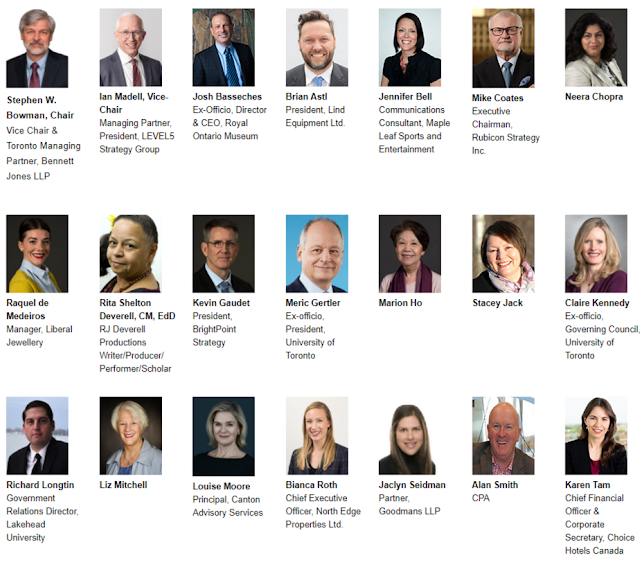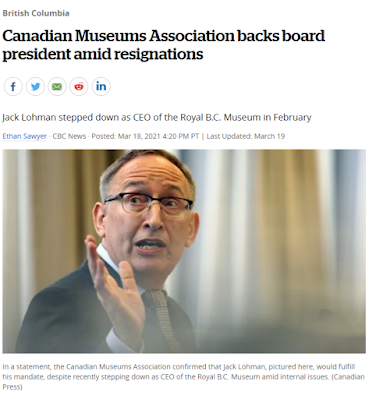Research Column | Brooke Downey
In my final article for Musings, I want to discuss a frequently forgotten aspect of GLAMs: the Board of Directors. In particular, let’s look at their influence on labour decisions and why GLAM workers need to pay more attention to their roles.
I was inspired to discuss this topic after reading Vu Le’s article “The default nonprofit board model is archaic and toxic; let’s try some new models” at Nonproft AF. In this article, Le states:
"But how could boards not be crappy? We are talking about a structure where groups of volunteers who barely know one another, see one percent of the work, often don’t reflect the communities we serve, and who may have little to no experience running nonprofits, being given vast power to supervise leadership and determine values, policies, and practices."Many GLAM boards encounter these pitfalls, regardless of whether they’re nonprofits.
 |
| The Board of Trustees at the Royal Ontario Museum as April 2021 | Source |
Governance in GLAMs
The board’s role can be confusing because GLAMs have different operating and governance structures, leading to a lack of clearly defined duties. For the sake of simplicity, let’s divide boards into four models:
Arms-Length: Board members act in the best interest of the organization, working on the big picture and avoid getting involved in the day-to-day operations. This is typical for larger organizations.
Working: Board members act as both directors and staff, making decisions related to both. Often organizations with few or no staff have this model.
Managing: This one is in between arms-length and working. Again, typical for smaller organizations and is often found in the nonprofit sector.
Appointed: Board members are appointed by a separate body (i.e., government), which is the model found in Crown agencies like the ROM. Problems may arise around accountability and transparency, as organizations don’t get the final say in their board.
It’s important to get a clear understanding of the board structure when you’re applying for roles at a GLAM; it will impact your day-to-day. For example, a working board may micromanage and change an exhibition at the last minute.
 |
| An example of governance issues becoming public concern | Source |
Influence on Labour Decisions
Let’s take a look at a board’s influence on workforce decisions. Broadly, according to the Institute on Governance, their role is defined as “[determining] who has power, who makes decisions, how other players make their voice heard and how account is rendered.” In practice, a primary function of a board is to select the Executive Director/CEO.
Although selecting one member of staff doesn’t seem like a lot, most organizations implement a top-down leadership style. Leaders select their direct reports (e.g., senior management), decide on the organizational structure, and set the workplace culture. That single CEO selection by the board will spread across the organization and will be felt more strongly in smaller organizations.
Reflection on Governance
Now we can take a step back and return to the emerging professional’s point of view. Whenever I apply for a role, I look up at the organization’s board. Here are three key questions I ask myself:
1. Is the board mostly made up of funders?
If it is mostly funders, I worry that the staff views the board as a fundraising mechanism (whether to attract donors or thank them for their donation). Funders mostly come from the private sector or have family wealth, so I question how much they understand: the functions of GLAMs and the ongoing issue of low pay and bad benefits. These boards are often out of touch with the reality of the employment and working situation within the organization.
2. Does the board reflect the community the organization is in?
Since so many board decisions happen behind the scenes, we as the public don’t get to see how boards are selected. So, I want to know whether the board reflects the community. This is especially important for GLAMs that have equity, inclusion, and community in their values. We’re generally forced to rely on a board page on the website to see if they represent many different voices, but annual reports and governance policies can also give you some insight (if they're publicly available).
3. How large is the board, especially compared to staff?
Finally, I want to see how the board relates to staff. Does the board outnumber staff? That might point to a more involved board. A board that is too large (e.g., 10+ members) makes me question what the overall purpose and function of governance is at the organization.
So what?
GLAMs have a confusing system of governance and boards that don’t represent an organization’s focus or communities – so what? Boards play a big role in setting the agenda and structure of an organization. When we, as workers, ignore this role, they will continue to ignore us. Next time you’re applying for a job or being interviewed, check out the board and see if it raises any flags about the organization for you.


No comments:
Post a Comment
Note: only a member of this blog may post a comment.